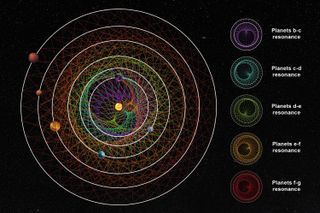Sub-Neptune planets that dance to the rhythm of the rest of their planetary systems are less dense than those that don’t, planetary scientists have found.
Although they are noticeably absent from the solar system, the most common planets in the Milky Way are called “sub-Neptunes,” planets that are between the size of Earth and the ice giant Neptune. An estimated 30 to 50 percent of sun-like stars have at least one sub-Neptune around them. But despite the ubiquity of these planets, scientists studying extrasolar planets, or exoplanets, have traditionally struggled to measure their density.
Depending on the techniques used for these measurements, sub-Neptunes appear to fall into two distinct categories: “inflated” and “non-inflated.” The question, however, is whether there are actually two distinct populations of sub-Neptunes or whether these differences are a result of the method used to measure densities. In this regard, new research from the University of Geneva (UNIGE) and the University of Bern (UNIBE) suggests that there are in fact two physically different families of sub-Neptunes. And inflated sub-Neptunes are more likely to be in resonance with their planetary counterparts.
Waltzing with planetary partners
Planets are said to be in resonance when, for example, one planet completes one orbit in the same time it takes another planet to complete two orbits.
HD 110067, an extraordinary resonant planetary system, was recently discovered. It lies 100 light-years from Earth. The six sub-Neptune planets in this system dance around each other in a precise cosmic waltz. The inner planet completes a full orbit in 9.1 Earth days, the next planet in 13.6 days, the third in 20.5 days, the fourth in 30.8 days, the fifth in 41 days, and the outermost planet in 54.7 days.
So for every orbit of the star that the outer planet completes, the inner planet completes six orbits. This means that these sub-Neptunes are supposed to be in 6:1 resonance. The other resonances between different pairs of planets in the HD 110067 system are 3:2, 3:2, 3:2, 4:3, and 4:3.
Related: Scientists Discover Surprising Ingredient in Exoplanet Cake Mix: Sulfur Dioxide
This rhythmic dance has been going on around the bright orange star HD 110067 for about 4 billion years, roughly the same length of time as the solar system. Fascinating as it is, it doesn’t explain why the sub-Neptunes in this system appear less dense.
The team behind the new research has proposed a few possible explanations for the lightness of the resonant sub-Neptunes; the most likely one seems to suggest that the process has to do with how they formed.

It is possible, the team says, that all planetary systems converge into a resonant chain during their initial existence. However, they believe that only 5% of systems can maintain this pace.
The breakdown of the resonant chain can lead to a series of catastrophic events, with planets colliding and often merging to form denser conglomerate worlds. This means that resonant chain systems can also retain their bloated sub-Neptunes, the team explains, because collisions and mergers increase the density of the same planets in non-resonant systems.
“The numerical models of the formation and evolution of planetary systems that we have developed in Bern over the last two decades reproduce exactly this trend: planets in resonance are less dense,” said Yann Alibert, professor at UNIBE’s Division of Space Research and Planetary Sciences and member of the discovery team, in a statement. “This study further confirms that most planetary systems have been the scene of giant collisions, similar or even more violent than the one that gave birth to our moon.”
Sub-Neptune confusion and detection bias
To estimate the density of a planet, astronomers need two pieces of information: the planet’s mass and its radius. Two methods are used to obtain mass measurements: transit time variation (TTV), which only works if a planet crosses the face of its star from our vantage point on Earth, and the radial velocity method, which uses the gravitational pull a planet exerts on its star to measure mass.
“The TTV method consists of measuring the variations in transit time. The gravitational interactions between planets in the same system will slightly modify the moment when the planets pass in front of their star,” explains Jean-Baptiste Delisle, a member of the team from the Department of Astronomy at the Faculty of Science at UNIGE, in the press release. “The radial velocity method, for its part, consists of measuring the variations in the speed of the star induced by the presence of the planet around it.”
Scientists realized that the TTV method tended to reveal sub-Neptune planets with lower density than those measured with the radial velocity technique.
By performing a statistical analysis, the team found that the radial velocity method takes longer to detect large, low-mass planets, such as bloated sub-Neptunes. This means that observations using the radial velocity method are more likely to be interrupted before a planet’s mass is estimated. This results in a bias toward higher masses and densities for planets characterized by the radial velocity method, while excluding less dense planets.
Further research showed that not only was the TTV method more likely to detect less dense exoplanets, but the densities of these planets were also lower in resonant systems than their counterparts in non-resonant systems, regardless of the method used to determine their mass.
With the confirmed existence of two distinct families of sub-Neptunes and the discovery of a link between bloated planets and resonant planetary systems, scientists are better positioned to understand the evolution of the most common type of planet in our galaxy.
They may also soon be able to explain, finally, why our solar system lacks such a world.
The team’s research is published in the journal Astronomy & Astrophysics.